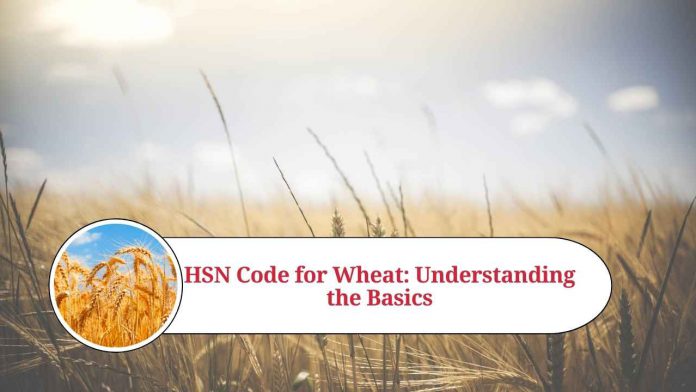Understanding the HSN Code for Wheat: A Comprehensive Guide
If you are in the business of buying or selling wheat, it is important to understand the Harmonized System of Nomenclature (HSN) code for this commodity. HSN codes are a globally recognized system of classification that is used to categorize goods for the purposes of international trade. In this blog, we will discuss the HSN code for wheat and provide you with a comprehensive guide to understanding it.
What is an HSN code?
An HSN code is a six-digit code that is used to classify goods for the purposes of international trade. It is a standardized system that is used by over 200 countries worldwide to identify and categorize goods. HSN codes are used to determine the customs duties, taxes, and other fees that are levied on goods that are imported or exported.
HSN Code for Wheat
The HSN code for wheat is 1001. This code is used to identify wheat and other grains that are classified under the heading of “Grain Milling Products.” This code is used to identify wheat and other grains that are in their natural state, as well as those that have been processed or prepared in some way.
Understanding the HSN Code for Wheat
The HSN code for wheat is a six-digit code that is used to identify this commodity for the purposes of international trade. Let’s take a closer look at each digit in this code and what it represents:
- The first digit (1) represents the chapter heading for “Live Animals; Animal Products.”
- The second digit (0) represents the heading for “Grain Milling Products.”
- The third digit (0) represents the sub-heading for “Wheat and Meslin.”
- The fourth digit (1) represents the product description for “Wheat and Meslin.”
- The fifth digit (0) is used for future use and is currently not used.
- The sixth digit (0) represents the tariff item. This digit is used to distinguish between different types of wheat or other grains.
Importance of the HSN Code for Wheat
The HSN code for wheat is important for several reasons. First, it helps to ensure that wheat is classified correctly for the purposes of international trade. This is important because customs duties, taxes, and other fees are based on the HSN code that is assigned to a particular commodity.
Second, the HSN code for wheat helps to ensure that the correct regulations and standards are applied to this commodity. For example, different types of wheat may be subject to different regulations depending on their intended use. By using the HSN code, it is possible to identify the specific type of wheat and apply the appropriate regulations and standards.
Third, the HSN code for wheat can help to simplify the process of trading this commodity internationally. By using a standardized system of classification, it is easier for buyers and sellers to understand the characteristics of the wheat that is being traded, and to ensure that they are complying with the relevant regulations and standards.
How to Determine the HSN Code for Wheat Products
To determine the HSN code for a particular wheat product, you will need to consider several factors, including the form in which the wheat is being traded, the degree of processing or preparation, and the intended use of the wheat. Some common HSN codes that are associated with wheat products include:
- 1101: Wheat or meslin flour
- 1102: Cereal flours other than wheat or meslin flour
- 1103: Cereal groats, meal and pellets
- 1104: Cereal grains otherwise worked (for example, hulled, rolled, flaked, pearled, sliced or kibbled), except rice of heading 1006; germ of cereals, whole, rolled, flaked or ground
- 1105: Flour, meal, powder, flakes, granules and pellets of potatoes
It is important to note that these codes are not exhaustive, and there may be other codes that are associated with specific types of wheat or wheat products.
Conclusion
In conclusion, the HSN code for wheat is an important system of classification that is used to identify and categorize this commodity for the purposes of international trade. Understanding the HSN code for wheat is important for anyone who is involved in the business of buying or selling this commodity. By using a standardized system of classification, it is possible to ensure that wheat is classified correctly, that the appropriate regulations and standards are applied, and that the trading process is simplified.
Read more useful content:
Frequently Asked Questions (FAQs)
What is an HSN code, and why is it important for wheat?
An HSN code is a standardized system of classification that is used to categorize goods for the purposes of international trade. It is important for wheat because it helps to ensure that the commodity is classified correctly, that the appropriate regulations and standards are applied, and that the trading process is simplified.
What is the HSN code for wheat, and what does it represent?
The HSN code for wheat is 1001. It represents the chapter heading for “Live Animals; Animal Products,” the heading for “Grain Milling Products,” the sub-heading for “Wheat and Meslin,” the product description for “Wheat and Meslin,” and the tariff item.
What types of wheat products are associated with different HSN codes?
Common HSN codes that are associated with wheat products include 1101 (wheat or meslin flour), 1102 (cereal flours other than wheat or meslin flour), 1103 (cereal groats, meal and pellets), 1104 (cereal grains otherwise worked), and 1105 (flour, meal, powder, flakes, granules and pellets of potatoes).
Are there any exceptions to the HSN code for wheat?
There may be exceptions to the HSN code for wheat, depending on the specific type of wheat or wheat product being traded. It is important to consult with a qualified expert or professional to determine the appropriate HSN code for a particular commodity.
How is the HSN code for wheat used in international trade?
The HSN code for wheat is used to determine the customs duties, taxes, and other fees that are levied on goods that are imported or exported. It is also used to identify the specific type of wheat and apply the appropriate regulations and standards.
Can the HSN code for wheat change over time?
Yes, the HSN code for wheat can change over time, as new types of wheat or wheat products are developed, and as regulations and standards change.
Is the HSN code for wheat the same in all countries?
While the HSN code for wheat is a globally recognized system of classification, some countries may have variations or modifications to the code for specific types of wheat or wheat products.
How can I find the HSN code for a specific type of wheat or wheat product?
You can consult with a qualified expert or professional to determine the appropriate HSN code for a particular commodity, or you can search for the code online using the Harmonized System of Nomenclature.
What are some of the challenges associated with using the HSN code for wheat?
Some of the challenges associated with using the HSN code for wheat include the complexity of the system, the need to stay up-to-date with changes in regulations and standards, and the potential for variations or modifications to the code in different countries.
Are there any penalties for using the wrong HSN code for wheat?
Yes, there can be penalties for using the wrong HSN code for wheat, including fines, delays in customs clearance, and other fees. It is important to ensure that the correct code is used to avoid these penalties.




















